As reviewed by 
Overview
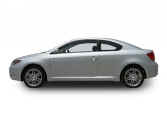 Toyota's all-out attempt to capture
America's Generation Y buyers of hot-looking, hot-performing small cars
started last year with the simultaneous introductions of the Scion xA
5-door hatchback runabout and the xB micro-van, but they are calling the
new tC hatchback coupe the first true Scion. The tC is built on the same
chassis as the Toyota Avensis, which is sold only in Europe, and uses
the 2.4-liter inline four-cylinder engine used throughout the American
Toyota lineup, but that doesn't mean this is just another Toyota. This
little rocket was developed in only 13 months with a single purpose in
mind.
Toyota's all-out attempt to capture
America's Generation Y buyers of hot-looking, hot-performing small cars
started last year with the simultaneous introductions of the Scion xA
5-door hatchback runabout and the xB micro-van, but they are calling the
new tC hatchback coupe the first true Scion. The tC is built on the same
chassis as the Toyota Avensis, which is sold only in Europe, and uses
the 2.4-liter inline four-cylinder engine used throughout the American
Toyota lineup, but that doesn't mean this is just another Toyota. This
little rocket was developed in only 13 months with a single purpose in
mind.
The Scion tC means to make mincemeat of
the Honda Civic that is so popular with Gen Y drivers by offering a
single, very well equipped model at a nearly unbeatable low price and a
menu of options that will allow owners to built cars unique to their
tastes.
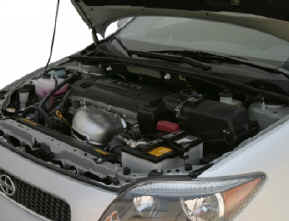 The engine is quiet, smooth, and plenty
powerful. The steering, ride quality and handling are commendable.
Braking is powerful, with ABS and electronic brake force distribution
standard. This car is surprisingly quiet, the interior materials are
first-rate, and attention to detail is evident. The bucket seats are
comfortable and there's enough room to suit tall drivers. A 160-watt
stereo is standard, and a full array of airbags is available.
The engine is quiet, smooth, and plenty
powerful. The steering, ride quality and handling are commendable.
Braking is powerful, with ABS and electronic brake force distribution
standard. This car is surprisingly quiet, the interior materials are
first-rate, and attention to detail is evident. The bucket seats are
comfortable and there's enough room to suit tall drivers. A 160-watt
stereo is standard, and a full array of airbags is available.
This is perhaps the best small Japanese
coupe we have ever driven, at a price that is ridiculously low.
Model Lineup
The Scion tC hatchback coupe ($15,950)
comes only one way, with no model name attached. (They apparently
couldn't call it xC because Volvo already uses XC90 for its sport
utility). It comes with all the major comfort and convenience items
built in, including air conditioning, power steering, brakes, locks and
mirrors, a tilt wheel, a 160-watt Pioneer 6-CD changer AM/FM setup,
sport bucket seats with cloth seating and position memory, two-tiered
console, reclining front and rear seats, keyless entry, engine
immobilizer, cargo cover, and a dozen other items.
There are only tw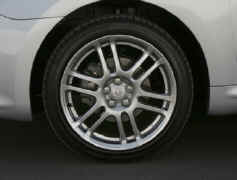 o
factory-installed options, the automatic transmission at $845 and the
side and roof air bag system for $650. To make the car more palatable to
more people, Scion has chosen a menu of 40 different freestanding
options, more than any other car in its class, ranging from a $4500
supercharger kit good for 200 horsepower to a selection of different
chrome and leather shift knobs. Special Toyota Racing Development (TRD)
high-performance items for the Scion tC include 18- and 19-inch wheels,
a lowering kit, struts and shock absorbers, rear anti-roll bar, a
high-performance clutch, a quick shifter, a stainless steel muffler, and
a shift-point indicator light kit. Toyota's high-performance arm Walk-around
o
factory-installed options, the automatic transmission at $845 and the
side and roof air bag system for $650. To make the car more palatable to
more people, Scion has chosen a menu of 40 different freestanding
options, more than any other car in its class, ranging from a $4500
supercharger kit good for 200 horsepower to a selection of different
chrome and leather shift knobs. Special Toyota Racing Development (TRD)
high-performance items for the Scion tC include 18- and 19-inch wheels,
a lowering kit, struts and shock absorbers, rear anti-roll bar, a
high-performance clutch, a quick shifter, a stainless steel muffler, and
a shift-point indicator light kit. Toyota's high-performance arm Walk-around
The look of the Scion tC is one of
purposeful performance. It's not blatant, and it doesn't come with
spoilers, rocker moldings or wings, but all the ingredients are there.
The somewhat bland overall look is meant to be "a blank
canvas" for young hot-rodders and customizers. The standard
panorama glass roof is an unexpected bonus in this price class, fitted
without gaskets for a tight, no-creaks fit. It filters 97 percent of UV
rays and 100 percent of infrared, to avoid damage to occupants.
The doors are quite long for such a small
car, and the door handles of the reach-around-and-pull variety that we
like. The long rear side window suggests a two-door sedan more than a
hatchback coupe, and makes the design flow from front to rear
gracefully. Wheel arches are exaggerated, suggesting that larger tires
and wheels will be fitted as soon as the car is bought (or the buyer can
opt for the 18- or 19-inch factory wheels and tires).
The body panel fits are typically Toyota,
tight and straight, and quality leaks from every pore. The tC is the
first purpose-built Scion, the other two having been developed from
concept vehicles, and although it is inexpensive, it is anything but
cheap.
Interior Features
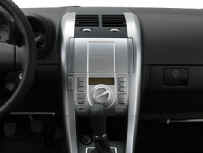 Inside the Scion tC, there are lots more
positive surprises. Materials are first-rate, there aren't a whole lot
of different grains and textures, and the swoopy brushed-metal center
stack housing vents, sound system and climate control system, is a
marvel of modern design. Everything fits together beautifully, works
intuitively and looks great.
Inside the Scion tC, there are lots more
positive surprises. Materials are first-rate, there aren't a whole lot
of different grains and textures, and the swoopy brushed-metal center
stack housing vents, sound system and climate control system, is a
marvel of modern design. Everything fits together beautifully, works
intuitively and looks great.
The front bucket seats look and feel like
they were designed for racing, but that doesn't mean to say they're too
narrow or too hard. Very comfortable, with enough fore/aft adjustment to
suit very tall American drivers regardless of age. The driver's and
shotgun seats can be reclined all the way down into what Scion calls a
"sleep" position, and the rear seats recline through 10 stops
and 45 degrees of recline to convert the interior into a conversation
bin. With seats up, there's more than 26 inches of cargo length there;
with the second seats dropped, almost 60 inches; and with the front
passenger seat folded over, almost 104 inches of cargo length available.
There are lots of convincing little
touches indoors, like the mechanical seat position memory on the front
bucket seats, the 60/40 split folding rear seat, the very decent amount
of storage space with the seats down, the dead pedal for the driver's
left foot, fully closing vents, and a cover for the stereo system's
faceplate. A knee airbag is standard, the first US Toyota to have this
feature.
Speaking of stereos, the base
Pioneer/Scion single-CD system packs a user-customizable welcome screen,
MP3 capability, four speakers and 160 watts, with a 10-inch subwoofer
optional and a 6-CD slot changer and XM satellite radio also available
at extra cost. The three-pod instrument panel is amber-illuminated,
deeply tunneled and easy to use, day or night, as are the balance of the
instruments and controls.
is
already working on a 300-horsepower package of parts for the lunatic
fringe.
Driving
Impressions
The engine in the Scion tC has been
around in one form or another as a car and truck power-plant for many
years, continuously improved for power, torque, and Toyota levels of
quietness and reliability. It comes with electronic variable valve
timing for good low end torque development, and twin balance shafts for
smoothness. Tuned to 160 horsepower and 163 foot-pounds of torque for
this application, the engine is quiet, smooth, and plenty powerful in a
2900-pound car, and at full throttle, it sounds powerful without being
intrusive, because it has a valved muffler that opens up at high rpm and
can be worth as much as 5 horsepower.
The transmission gearing in the automatic
that we drove for this test is wholly unsuitable for big-time
acceleration, with an overall ratio of just over 10:1 (the first-gear
ratio times the axle ratio), while the manual is almost 50 percent
lower, almost 15:1, for maximum acceleration in first gear. However, the
automatic does move out smartly, it's obviously much easier to live with
in gooey traffic, and will get significantly better highway mileage than
the manual, which is saddled with a very low 4.235 axle ratio. No
complaints on the power-train.
The steering, ride quality and overall
handling of the Scion tC were commendable, in part due to its 106-inch
wheelbase, longest in the class. It steers with a hefty touch, but
accurate pointing, and transitions are easy and without drama. That's
because the tC has low-cost MacPherson strut front suspension coupled
with an expensive independent double-wishbone rear suspension not found
on many cars in this price class. Bridgestone Potenza tires originally
developed for the hot-rod Lexus IS 300 are standard.
Braking is accomplished with a
combination of ventilated front and sold rear discs, 10.8 inches front
and 10.6 inches rear, generously sized and quite powerful for a car this
light, with both ABS and electronic brake force distribution built into
the standard price. The pedal feel and travel is very much to our
liking, with very little dead space at the top of the pedal travel.
One of the things that came through after
our initial drive was the quietness of this small, inexpensive car,
which turns out to have more sound insulation in it than any other
Toyota product this side of a Lexus V8. The front suspension strut tower
is connected to both the dashboard and to the A-pillar for extra
strength and solidity, and the rear suspension has three steel sub-frame
supports that also add quietness and rigidity.
Summary 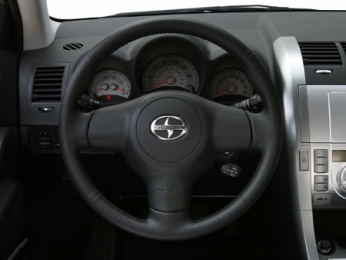
If your physical size and family size can
tolerate the tC, it can most certainly transport and entertain you for
less than $17,000. With the killer 40-item option list and the TRD parts
catalog, you can build a unique car. All it takes is money. There's
nothing missing. It's all here.
For performance-minded youth, the option
list and the TRD parts list will enable you to build a unique Scion tC
hot rod without ever leaving the dealership, and the hot-rod parts carry
the same warranty as the car itself.

![]()

![]()